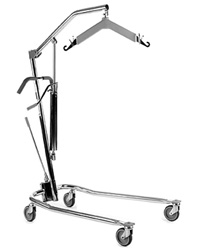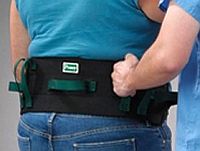Some medical professionals are faced with the difficult task of lifting and transporting patients to different departments within a medical facility.
Most problems associated with lifting and transporting patients is the stress and strain it puts on the transporters upper and lower back and legs. Heavy lifting patients can cause injuries to the transporter, depending on the size of the patient. This injury may result in a leave of absence to allow time for them to heal. This problem can be solved with proper lifting equipment that will allow the caregiver to safely, quickly and effectively lift the patient while still giving the patient the respect and the dignity they deserve.
Though caregivers may be taught the appropriate way for lifting patients safely and positioning a patient, things can still go wrong. Unexpected movements and the patient’s ability to help in lifting all play a factor in how smoothly transport will go. If caregivers injure themselves while picking up a patient they can potentially cause injury to the patient as well. Lifting equipment gives medical facilities more efficiency because patients are moved in a faster time frame. Caregivers can also transport more patients without the assistance of co-workers, which means more productivity in the work place.
 Hoyer Lifts
Hoyer Lifts
Hoyer lifts are perfect for both electronic or manual lifting and offers fast assembly with no tools necessary. It is safe to use and can lift up to 450lbs safely. It’s easy set up and disassembling makes it convenient and portable to use on multiple patients throughout the facility. Bedside hoyer lifts also have a variety of sling options that will make lifting comfortable for the patient. Its lifts also offer convenient transfers from bed to wheelchairs or the bathroom. This type of lifting system can cost $450 to $2000 depending on the level of demands your particular facility has. It can also depend on the needs of your patients as well.
Gait Belts
 Another lifting option is gait belts, which offers support to the patient as they are lifted out of their bed or wheelchair. Transfer gait belts are great for helping patients who are too weak to move on their own however, they have some mobility. It helps the patient stay upright, which is important in transferring. It placed around the patient but is removed once the transfer is complete. It takes most of the pressure and weight off of the caregiver’s back and legs and helps lifting and maneuvering the patient much simpler. They are affordable and can be priced between $17.00 to $45.00 dollars depending on its simplicity, style and amount of extra handles. It is much more economical to buy these transfer belts in bulk especially if your medical facility houses many transfer patients.
Another lifting option is gait belts, which offers support to the patient as they are lifted out of their bed or wheelchair. Transfer gait belts are great for helping patients who are too weak to move on their own however, they have some mobility. It helps the patient stay upright, which is important in transferring. It placed around the patient but is removed once the transfer is complete. It takes most of the pressure and weight off of the caregiver’s back and legs and helps lifting and maneuvering the patient much simpler. They are affordable and can be priced between $17.00 to $45.00 dollars depending on its simplicity, style and amount of extra handles. It is much more economical to buy these transfer belts in bulk especially if your medical facility houses many transfer patients.
